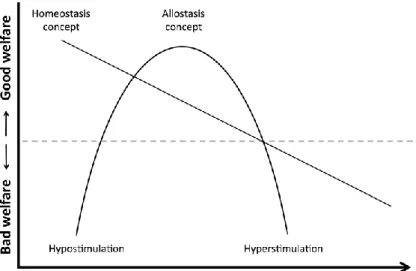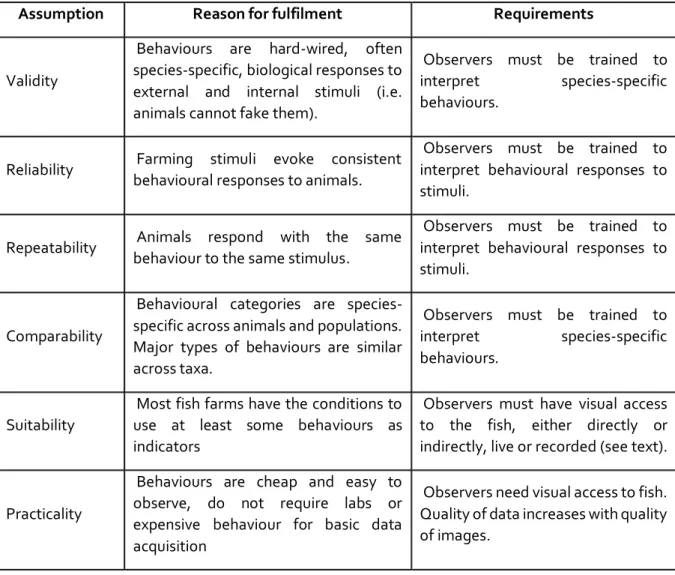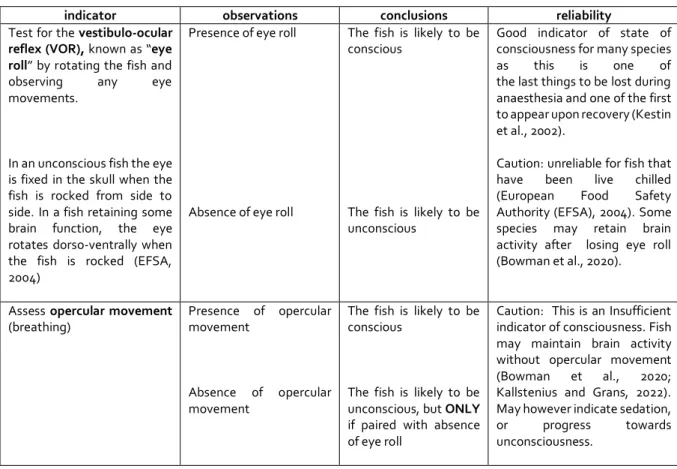STATE OF THE ART IN FISH WELFARE
FISH FARMING IN THE EU: CASE STUDIES
Each criterion is divided into the general life stages of the animal, which can generally correspond to rearing stages in the agricultural environment: Eggs, larvae (hatchery), juveniles (rearing, rearing), adults (outgrowth) and spawners (brood). For each criterion, the existing knowledge about the biology in nature is therefore overlapped with the existing knowledge about agricultural conditions, which will implicitly make it possible to draw conclusions about the welfare of the species regarding this criterion. It is unclear whether the provision of safety from predators, forage, mates and preferred water parameters overrides the need to cover the home range it moves over in the wild.
Depth Range: Similar to the native range, the depth range in the wild covers the needs for food and shelter from unfavorable water parameters or predators. Less stress at stocking density in cages and ponds needs to be tested in the context of farming. On the other hand, juveniles and adults can be found near aquatic vegetation, and in the laboratory the juveniles immediately sought shelter.
Reproduction: Although bream are known to spawn in nature in winter-spring, there is no known mating system and courtship. Aggregation: In the freshwater phase, Atlantic salmon are quite solitary, although specimens live nearby. Since there is no specific density in the wild, clues from laboratory studies can help recommend stocking densities in captivity.
However, there are species that spawn spontaneously in captivity and there is evidence that egg quality in these cases is higher than in the case of sea bass (Forniés et al., 2001). Yet this individual variation can be classified in the proactive-reactive continuum, where more proactive animals respond similarly to stressors and respond differently than reactive ones (Castanheira et al., 2017). An important aspect to consider in the treatment component is the farming method.
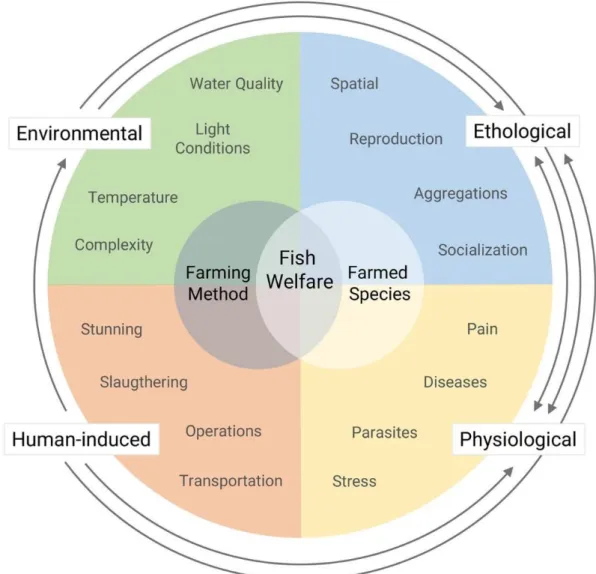
IMPROVING WELFARE IN EU FISH FARMING: TRANSLATING KNOWLEDGE INTO ACTION
Gathering knowledge
Therefore, for this purpose, we propose the creation of training programs designed and aimed at all levels of personnel who directly or indirectly deal with animals in the fish farm.
Monitoring and assessment
Note that these challenges are not only due to policy and regulations and can arise from economic cycles, societal developments or even climate change (Huntingford et al., 2023). OWIs rearing stage base level Measurement type Traits reference Aggression breeding, brooding, growing animal individual High/low negative (high dose=poor welfare)* Martins et al (2012). Investigative activity breeding, brooding, growing animal individual high/low Positive (high rate= good welfare) Martins et al (2012), Roque et al (2020).
Anticipatory activity broodstock, hatchery, growing animal individual high/low positive Martins et al (2012) Foraging behavior broodstock, hatchery, growing animal group high/low positive Martins et al (2012), Marino et al. General appetite breeding animals, hatchery, growing animal, resource Group high/low positive Noble et al (2021), Marino et al (2020), Roque et al (2020) Group swimming behavior breeding animals, hatchery, growing animal Group shoal/school/disperse positive Martins et al (2012), Marino et al. Stereotypical behavior parent animals, hatchery, growing animal individual yes/no or high/low negative Martins et al (2012), Roque et al (2020).
Fertile surface activity, birds, growing animals. The bodies. FishEthoBase.net, Roque et al. 2020). Using spacebirds, babies, growing resources Group all space used/some parts avoided;. suitable positive species FishEthoBase.net, Roque et al. 2020) Vacuum behaviors of chicks, chicks, growing animals, individual yes/no or high/low negative Martins et al (2012).
Ventilation rate of birds, nurseries, growing animal individuals, Martins et al (2012), Noble et al (2018), Roque et al (2020).
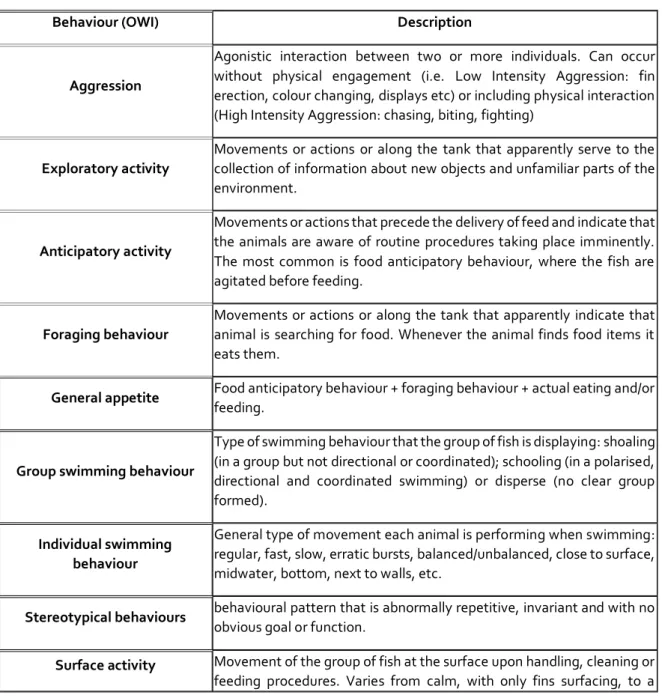
Actions to improve welfare
- Improving fish welfare during life in captivity
- Improving welfare at slaughter
Use of space Measure of how and how much space of the rearing environment is used by the animal. The addition of hatchery mats to the bottom of the tanks offers a wide range of positive effects, as it has been demonstrated on different salmon species. It should be noted that anesthetics can reduce stress and thereby improve welfare, but can also have unwanted side effects that reduce the welfare of the fish and should therefore always be used with caution.
The loading of fish is a crucial phase with a high potential to influence fish welfare, and evidence suggests that this part of the transport process is the most stressful phase for most farmed fish species. It can also potentially affect the welfare of the next group of fish in transport. According to EFSA (2009a, 2009b, 2009c, 2009d), the implementation of humane stunning methods should take into account animal welfare throughout the process: fasting, selection, collection, transport, handling and the stunning protocol.
The effect of elevated carbon dioxide, ammonium and total organic carbon levels and low pH on fish welfare must be addressed. This is a key step that will determine the success of performing the stunning method. A good indicator of the state of consciousness for many species, as it is one of the last things to be lost during anesthesia and one of the first to appear after recovery (Kestin et al., 2002).
The effect and duration of the stunning depends on the severity of the damage to the nerve tissue and the degree to which the blood supply is reduced (Humane Slaughter Association, n.d.). This is determined by the force and speed of the blow, as well as the weight and shape of the hammer or club (EFSA, 2009b). In general, electrical anesthesia works by stimulating the higher nerve centers to "cause their dysfunction, either by induction of epileptiform activity or by complete cessation of function" (Robb et al., 2002).
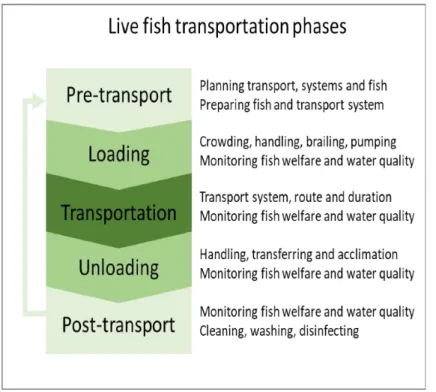
Knowledge transfer
However, there is a new technology that claims to be able to perform spiking using artificial intelligence to precisely determine the position of the brain in each individual fish (Shinkei systems, n.d.). Although still in the experimental phase, it shows a promising path that adds to the package of possibilities for commercial fish farming. It is advisable and realistic to consider in advance that, apart from biological factors related to the species, there are economic and operational issues to consider when deciding to choose the humane stunning and stunning method that best suits each individual coincidence.
Regardless, it is worth noting that welfare concerns are growing at the EU level and should sooner or later become regulated and enforced (Giménez-Candela et al., 2020). More importantly, in terms of production, the use of good welfare practices at slaughter (as well as during fish life) has very positive effects on product quality (Bermejo-Poza et al., 2021; Matos et al., 2010). ; Poli, 2009; Poli et al., 2005; Zampacavallo et al., 2015) and responds to requirements already used by third-party certification labels (e.g., Friend Of the Sea, n.d.; Studer et al., 2020). Failure to do so can jeopardize the entire process and can be avoided, resulting in fish discomfort and breeder frustration.
PREPARING THE FUTURE OF EU AQUACULTURE
In addition to allowing for a deeper understanding of the causes and consequences of welfare under agricultural protocols, the implementation of cameras, sensors, artificial intelligence and other high-tech methods will enable the optimization of resources to improve welfare and could streamline the identification of OWIs and the development of EE strategies. Successful implementation of humane stunning and slaughter protocols in fish farming must depend on solid identification of effective stunning. Detailed knowledge of technical and biological aspects of welfare and meat quality as well as the economic assessment of economic costs versus benefits are worth investigating.
4.2- Priorities for financing the improvement of welfare and production of farmed fish in the EU. In addition to providing funding to match the research priorities proposed in 4.1 (either through competitive calls or other types), we believe that the following topics warrant financial support. As described in 3.3, there are several solutions that can improve the lives of farmed fish (EE, improved equipment and handling protocols, assessment tools, etc.).
This measure will accelerate the assimilation of a fundamental measure to improve fish welfare as well as production. While other methods of improving the welfare of farmed fish can be achieved in a "cheaper" way, the purchase and application of stunning equipment is financially demanding, especially for small-scale farms. Providing access to this equipment to as many companies as possible, as well as the training to operate it correctly (see next point), should become a fundamental priority to improve fish welfare and production.
As set out throughout this report and in 3.1, knowledge and training are the cornerstone of welfare.
FINAL RECOMMENDATIONS
Improving the welfare of the animals will directly and positively affect the fish themselves and indirectly improve the condition of the whole industry. Report of the technical committee to investigate the welfare of animals kept in intensive farming systems. Species specific welfare aspects of the main stunning and killing systems for farmed fish: Rainbow trout.
Species-specific welfare aspects of the main stunning and killing systems of farmed Atlantic salmon. Species-specific welfare aspects of the main stunning and killing systems of farmed sea bass and sea bream. Species-specific welfare aspects of major farmed carp stunning and killing systems.
Opinion of the Scientific Panel on Animal Health and Welfare (AHAW) on a request from the Commission concerning the welfare aspects of the main stunning and killing systems of the main commercial animal species. Fish Behaviour: Determinants and Implications for Welfare, in: Kristiansen, T.S., Fernö, A., Pavlidis, M.A., van de Vis, H. Eds.), The Welfare of Fish, Animal Welfare. Domestication and Welfare in Farmed Fish, in: Teletchea, F. The effect of tank coverage on the welfare of farmed Nile tilapia.
Welfare of farmed fish in different production systems and operations, in: Kristiansen, T.S., Fernö, A., Pavlidis, M.A., van de Vis, H. Eds.), The Welfare of Fish, Animal Welfare.

